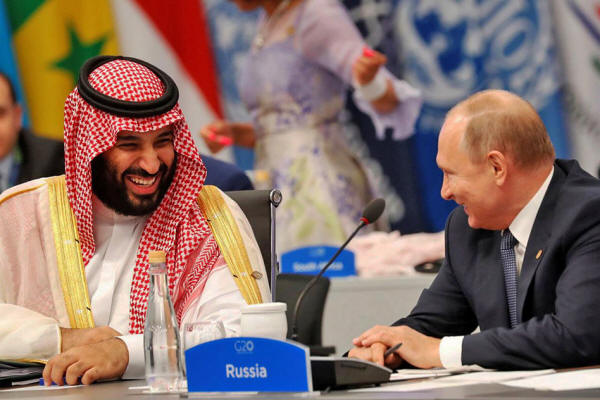|
by Simon Watkins
Historically, Russia goes to great lengths to hide or disguise its strategic intentions but it clearly feels empowered enough in the Middle East to very obviously stake its claim in the region - excluding, for the time being only, Saudi Arabia - by stating that a slew of Russian companies are to spend up to US$20 billion on oil projects in Iraq in the near term.
Before this announcement - which specifically mentioned Zarubezhneft, Tatneft, and Rosneftegaz as companies interested in pursuing specific but as yet unnamed projects, in addition to those Russia companies already active in the country (including Lukoil, Bashneft, and GazpromNeft) - Russia had adopted its usual stealth approach to building up its presence in Iraq.
The oil and gas prize for the Russians in Iraq is, of course, huge, but many in the industry do not realize that it is still underestimated.
The official figures for oil are that Iraq has around 149 billion barrels of reserves (18 per cent of the Middle East total and 9 per cent of the global total) and is currently the second-largest oil supplier in OPEC, after Saudi Arabia.
All of this oil coming at a mean average 'lifting cost' per barrel in Iraq of US$2 to US$3 per barrel, according to the IEA, at least as competitive as Saudi Arabia.
For gas, the official figures are slightly less impressive, but they are likely even more underestimated than the oil figures, with Iraq having about 135 trillion cubic feet of reserves (the 12th largest in the world), mostly associated at the moment with oil fields in the supergiant fields in the south of the country.
However, despite the
occasional increase in reserves estimates over the past few years -
extremely modest by the standards of its neighbors, incidentally -
much of Iraq still remains unexplored or under-explored compared
with other major oil-producing countries.
Even this, though, might prove on the low side, added the IEA, as a detailed study by Petrolog around that time reached a similar figure but did not include the parts of northern Iraq in the KRG area or examination of the geological anomalies prevalent in the central and western regions of the country.
Even using the much more conservative USGS number, Iraq had just a decade ago only produced around 15 per cent of its ultimately recoverable resources, compared with 23 per cent for the Middle East as a whole at that time.
At that point, of the 530 potential hydrocarbon-bearing geological prospects identified by - only - geophysical means in Iraq only 113 had been drilled, with oil being found in 73 of them, a success rate of 65 per cent.
Although more of these geophysically-identified sites have now been drilled many more new ones have arisen due to identification by more sophisticated analysis of seismic and historical data.
This is one of two key reasons why Russia has exploited every opportunity to expand its footprint in the north and south of Iraq.
In the north it has been extremely successful so far in using its corporate proxy, Rosneft, to gain control over key elements of the region's oil and gas infrastructure while in the south it had been forced by the US's own former ambitions to tread more stealthily.
Although it has always been able to rely on being able to use Iran's political and military over Iraq for its own purposes, these had to be sidelined for a while, at least whilst the real power in Iraq - Moqtada al-Sadr - was getting settled in to his power-broking role.
As this was initially
founded on the ultra-nationalist message ('Iraq for the Iraqis, with
no undue foreign influence', in essence) of his election-winning 'Sairoon'
power bloc, Moscow was able to tinker only the edges.
The most recent example of this - and a template for such strategies for any aspiring superpower, frankly - was,
As highlighted in-depth by OilPrice.com at the time, Russia's Stroytransgaz (an almost unknown Russian oil and gas company - except by the U.S. whose Office of Foreign Assets Control extensively sanctioned it in 2014) signed a preliminary contract with the oil ministry in Baghdad for oil and gas exploration in Anbar province (a wasteland as far as Iraq's oil and gas sector development goes).
On the face of it, there
was - and is - no real prospect of any substantial amounts of oil or
gas being recovered from its Block 17 and additionally stationing
any normal oil and gas workers there would be perilous to say the
least, as it is an area torn by warring tribal communities, which
even Islamic State avoided where possible.
In this context, then, Block 17 in Anbar - and the US$20 billion investment announced last week - makes perfect sense for the Russians, as it intends to secure what the U.S. military used to call 'the spine' of Islamic State where the Euphrates flows westwards into Syria and eastwards into the Persian Gulf.
Along the spine running from east to west are the historical ultra-nationalist and ultra-anti-West cities of Falluja, Ramadi, Hit and Haditha, and then there is Syria, with its key strategic ports of Baniyas and Tartus.
By happy 'coincidence' both Baniyas and Tartus are also extremely close to the massive Russian Khmeimim Air Base and the S-400 Triumf missile system.
Although the base only came in to operation in 2015 supposedly to help in the fight against Islamic State, Russia appears to have changed its tactical plans for it, having also signed a 49 year lease on it, with the option for another 25 year extension.
A short flight away is Russia's Latakia intelligence-gathering listening station.
|


